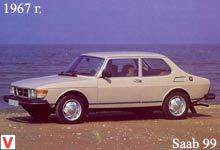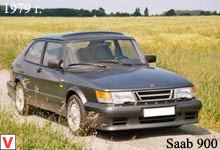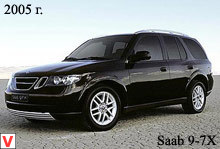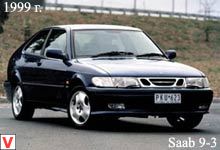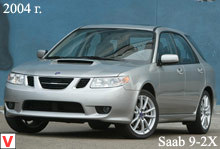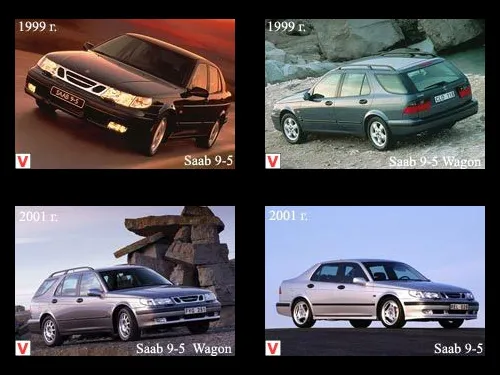
Saab 9-5, which appeared in 1997, changed the model with the longest index in the company's history - 9000. The new index turned out to be “twisted” - the “9 to fifth power” style was used on the car and in the booklets. The car is created on the same platform with the car Opel Vectra. On some nodes it is unified with Opel Omega.
In particular, a V6 engine with “Opele” roots was used. The Swedes equipped this three-liter engine with an Ecopower system with an original low-pressure asymmetrical turbocharger and four valves per cylinder. Like the four-cylinder power units - 2.0 l and 2.3 l - the V6 received a proprietary Trionic 7 control system. Moreover, the two-liter one was produced in two versions, differing in boost pressure and, accordingly, power. The more modest (0.4 bar, 150 hp) had the “t” index, and the one that was more powerful (0.95 bar, 185-192 hp, depending on the country) - “Turbo”.
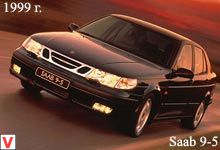
Also in two versions, there is a 2.3 liter engine: 170 hp and 230 hp The latter is intended solely for the most dynamic modification of Aero. Salon Saab 9-5 in comparison with the interior of the progenitress of the 9000th model is less angular, all upholstery lines have become softer and have their logical conclusion. Landing the driver is more convenient, and the number of seat adjustments has increased from four to five, and their range has increased. You can adjust the position of the steering wheel not only in the longitudinal direction, but also in height. The instrument panel displays a minimum of information.
These are fuel level and coolant temperature indicators, a tachometer and an automatic transmission mode indicator, and in the center there is a rather large scale of the speedometer. At 9-5 computer readings displayed on a separate display at the top of the center console. This is more convenient. During night driving, you can click on the night panel button. And then only the speedometer light up to 140 km / h is working. The rest of the scales disappear in the dark, the screens of the on-board computer and the air conditioner go out. True, the illumination of all the buttons remains, and you will not have to look for them blindly.
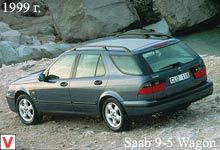
Another distinctive feature of the 9-5 is the location of the ignition lock. It is installed on the floor tunnel, near the handbrake handle. Having muffled the engine, the driver will be able to pull out the key only after turning on the reverse gear. This mechanical “anti-theft” is paired with electronic alarm, the control buttons of which are located on the ignition key housing. The button of the remote trunk opening was also attached here. There are a number of pleasant things.
This cupholders, leaving the most unusual places. And rear head restraints, reclining to improve visibility. And a great Harman-Kardon audio system with a CD player and nine speakers. True, the latter is included in the list of additional equipment. Comfortable fit is achieved by a wide range of seat adjustments. In addition, Saab inherited heated front seats with three modes of operation from its predecessor (you can also order the seat ventilation system - a very convenient option, especially if there are leather seats in the cabin), blowing in not only front but also rear side windows.
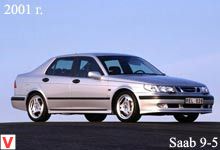
The trunk is large and comfortable, if desired, its volume can be further increased by folding the backs of the rear seats, both completely and in parts. This possibility is rarely found on sedans of this class. Also in the back seat has a hatch to accommodate skis or other long things. The first year of the Saab 9-5 was presented only body "sedan".
In the fall of 1998, the wagon was added to the range. He retained the successful features of the Saab 9-5 sedan - a characteristic front, dynamic lines of the sidewalls, a massive stand behind the rear doors. But thanks to the long roof with an aerodynamic visor, other rear doors and the design of the rear windows, the Wagon was even more stylish. He looks massive and thoroughly Swedish - and at the same time aircraft-like easily and swiftly. Universal beautiful, recognizable, solid. The cabin has a traditional and comfortable interior, which is also famous for the Saab 9-5 sedan. A typical panel with an aircraft abundance of buttons and inscriptions of green glow.
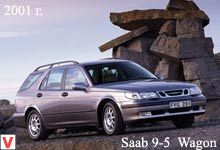
The ignition lock, of course, is down below, right behind the gearshift lever. The back of the seat folds in parts. The trunk is not the largest in the class, but very comfortable. The floor is flat - and remains equally flat after folding the rear seat.
Special lights illuminate the area under the open tailgate. It is necessary when the "wipers" are working to turn on the reverse and the window wiper of the fifth door will start working. You can open the trunk or key, or by pressing a button on the driver's door, or with a key fob - the keys or handles on the trunk lid itself, alas, no. The fifth door opens high and at a right angle, so that even a 1.8-meter-tall man can walk under it without bending his head. In 2000, this model was upgraded.
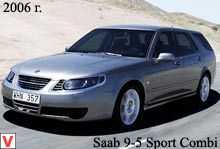
Power 2,3t brought up to 185 hp Changed the list of options - in particular, there was a rain sensor, a new key with built-in buttons for remote control of the central lock and a more sophisticated filter in the cabin ventilation system. In 2005, the last generation Saab 9-5 was introduced. The car comes with a sedan and wagon (9-5 Sport Combi). Both cars differ from models of the previous generation with progressive design and improved dynamic performance: all versions of Saab 9-5 of 2006 are equipped with engines of increased power - up to 260 hp.
The exterior of the model is based on the image of the Saab 9X concept of 2001, the alterations touched the interior - the design of the dashboard and the cabin was updated. The basic version of the Saab 9-5 received the standard Arc 2005: an opaque sunroof, leather seats, heated front seats, etc. Saab 9-5 is a good choice for those who appreciate not only comfort in the car, but also dynamics and style.
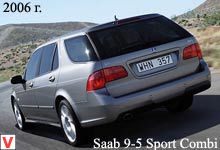
There is in the model range of the Saab 9-5 experimental car with the Aero BioPower prefix, equipped with a unique power plant. The standard 2.3-liter 9-5 Aero turbo engine was upgraded to enable the use of biofuel - bioethanol (alcohol). Bioethanol is a high octane fuel (104 RON). Therefore, under the use of this type of fuel, the base engine has to be slightly modified: to install on it a new engine management system and upgraded parts of the gas distribution mechanism.
In addition, BioPower vehicles have to use special materials in the fuel system that are resistant to this type of fuel. As a result, a car equipped with such an engine can drive on both gasoline and bioethanol, however, in the latter case, the engine not only provides more power, but also turns out to be much more environmentally friendly than the gasoline version. When working on bioethanol, the 2.3-liter turbocharged BioPower engine is able to reduce the amount of harmful emissions into the atmosphere by 70% and produces 14% more power. That is, the 2.3-liter Saab 9-5 Aero engine when using bioethanol delivers a power of 310 liters. from.
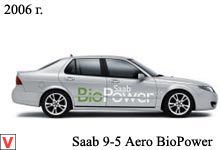
(instead of 260 in the basic version), and the power of a simpler 2.0-liter turbo engine increases from 150 to 180 liters. from. If you pour ordinary leaded gasoline into the tank, it will take 8.5 seconds to accelerate to 100 km / h, and on bioethanol this figure will be 7.9 seconds. Currently, this car is already sold in Sweden. Serial production of SAAB cars with a hybrid power plant will begin no earlier than 2009–2010. The Swedish automaker decided to create a completely new generation of model 9-5.
While it is only in the plans. Preliminary name of the new model SB650. The car is planned to be produced in the sedan and wagon. It will be designed on the new Epsilon II platform, with which GM engineers will give more flexibility as well as increase in length. From the first generation Epsilon, the new Saab 9-5 borrows only the best qualities, in particular, twin front suspension forks and a multi-link rear axle, providing a sporty ride and excellent handling.
In addition, Saab will receive air suspension. From the bright features of the exterior, we can note the aggressive shape of the air intakes and the embossed hood flowing onto the wide grille.
